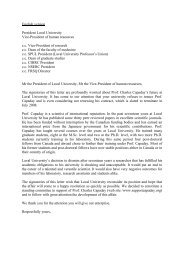Untitled - Laboratory of Neurophysics and Physiology
Untitled - Laboratory of Neurophysics and Physiology
Untitled - Laboratory of Neurophysics and Physiology
Create successful ePaper yourself
Turn your PDF publications into a flip-book with our unique Google optimized e-Paper software.
O5<br />
We now know what fly photoreceptors compute<br />
Uwe Friderich 1 , S. A. Billings 1 , Mikko Juusola 2 , <strong>and</strong> Daniel Coca 1⋆<br />
1 Department <strong>of</strong> Automatic Control <strong>and</strong> Systems Engineering, University <strong>of</strong> Sheffield, Sheffield, S1<br />
3JD, UK<br />
2 Department <strong>of</strong> Biomedical Science, University <strong>of</strong> Sheffield, Sheffield, S10 2TN, UK<br />
It has been known for some time that photoreceptors transmit more information when driven by stimuli<br />
which have ’naturalistic’ statistical properties <strong>and</strong> that processing <strong>of</strong> naturalistic visual stimuli involves<br />
nonlinear transformations <strong>of</strong> the input signals. Until now it was not clear which statistical features <strong>of</strong><br />
the stimuli the neurons are selectively ’tuned’ to respond to. Another major difficulty was to elucidate<br />
the computational mechanisms which explain differences in coding naturalistic <strong>and</strong> Gaussian stimuli.<br />
Here we used a functional model <strong>of</strong> Drosophila photoreceptor to fully characterize their underlying<br />
computational capabilities. The model was derived based on photoreceptor responses measured in<br />
vivo using naturalistic input stimuli, which the system experiences in its natural environment. In order<br />
to characterize the nonlinear transformations performed by photoreceptors we analytically computed<br />
the higher-order or generalized frequency response functions (GFRFs) <strong>of</strong> the identified nonlinear photoreceptor<br />
model. Using this approach, we demonstrate, for the first time that the observed increase<br />
in power <strong>of</strong> photoreceptor response, <strong>and</strong> shift towards higher frequencies as the mean light intensity<br />
increases, is the result <strong>of</strong> changes in the operating point <strong>of</strong> the photoreceptor, which produces a<br />
change in the shape <strong>of</strong> the magnitude <strong>of</strong> the frequency response functions. This suggests that the<br />
photoreceptor adaptation mechanisms are not tuned to fully compensate for the drop in intensity in<br />
order to achieve, in an efficient way - by exploiting the photoreceptor nonlinearity - a change in the<br />
shape <strong>of</strong> the magnitude transfer functions, which are optimal for the given mean intensity level.<br />
Furthermore, we examined the significance <strong>of</strong> both local <strong>and</strong> non-local high-order phase correlations<br />
for fly vision. We simulated the photoreceptor model using synthetic stimuli sequences incorporating<br />
local phase correlations (edges) <strong>and</strong> non-local phase correlations (quadratic phase coupling) superimposed<br />
with Gaussian white noise. By decomposing voltage output <strong>of</strong> photoreceptor somata into linear<br />
second- <strong>and</strong> higher-order responses, we explain the nonlinear mechanisms responsible for coding the<br />
local <strong>and</strong> non-local higher-order statistical features in the stimuli as well as improving their signal-tonoise<br />
ratio.<br />
To validate the results, we carried out electrophysiological experiments using a specially designed stimuli<br />
sequence, which allows extracting the nonlinear component <strong>of</strong> the photoreceptor response directly<br />
from data, without a model.<br />
Conclusion<br />
The frequency response decomposition employed in this study allowed us to reveal for the first time<br />
the quantitative relationship between the higher-order statistical properties <strong>of</strong> environmental stimuli<br />
<strong>and</strong> processing <strong>of</strong> these stimuli in fly photoreceptors. In light <strong>of</strong> the results, we argue that the goal<br />
<strong>of</strong> early sensory coding is to maximize sensitivity to higher-order statistical features <strong>of</strong> the stimuli<br />
that are behaviourally relevant to the animal whilst minimizing sensitivity to non-informative signals,<br />
to encode efficiently these features <strong>and</strong> increase their salience to facilitate further processing. Our<br />
framework elegantly explains the differences in coding <strong>of</strong> naturalistic <strong>and</strong> white noise signals <strong>and</strong> how<br />
this is achieved efficiently without a change in the response transfer function <strong>of</strong> the photoreceptor<br />
when the mean light intensity is constant. It also explains why <strong>and</strong> how naturalistic stimuli increase<br />
the rate <strong>and</strong> efficiency <strong>of</strong> information transmission.<br />
59



